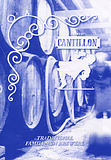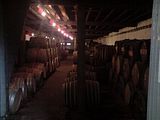 The Cantillon brewery stands in one of the less salubrious parts of the city of Brussels. I approached it from the city centre along run-down streets and through a pretty ethnically diverse part of the city. It sits opposite a disused lot where I guess once stood warehouses or apartments but now is home to weeds, rubbish and the odd four-legged creature. In one way it's not the most obvious site for a brewery but I guess the area has changed a lot since it was established 100 years ago.
The Cantillon brewery stands in one of the less salubrious parts of the city of Brussels. I approached it from the city centre along run-down streets and through a pretty ethnically diverse part of the city. It sits opposite a disused lot where I guess once stood warehouses or apartments but now is home to weeds, rubbish and the odd four-legged creature. In one way it's not the most obvious site for a brewery but I guess the area has changed a lot since it was established 100 years ago.
When you enter through the huge doors the first thing that hits you is an agreeable earthy, musty smell with a hint of stale beer. 100 years of beer seem to have soaked and permeated into every crack and crevice of the place. It's not a bad smell by any means and immediately pulls you further in to find out more.
The guide, whom I took to be one of the owners, was busy with an American family when I entered and when she had finished and given them their first beer sample, she approached me. The entrance fee is €5 which included two samples: one of Gueuze, a blended Lambic beer; and one of Kriek, a Lambic with cherries added during the brewing process. She gave me a quick history lesson and then went to pains to explain to me that the Lambics and Krieks brewed here are "proper" examples of the style. Not to be confused with the sweetened versions that some brewers pass off as the real thing, more about this later. The guide then explained to me how to tour the brewery, stopping briefly to admonish the American man who had picked up one of the sample bottles from its woven basket and therefore stirred the sediment, a big no-no! With that she let me on my way.
I had never been in a brewery before so I wasn't sure what to expect and seeing how it wasn't guided, I just followed the numbers in the guide book and on the walls to get around. To be honest, this is the best way to tour a brewery as you can poke around on your own and the guide book tells you everything you need to know.
I won't go into all the details, but there are some interesting facts about their brewing process.
For every batch Cantillon use 1,300 kg of cereal (35% organic wheat and 65% organic malt barley), 10,000 litres of water and 20kg of 3-year-old hops. The reason for the aged hops is because they will have lost some of their bitterness, or so I read.
 My tour took me past the hop boiler, up the stairs and reached the cooling tun room. This contained a vast, shallow copper bath into which the 7,500 litres of wort that remain after the first stages of the brewing process is pumped. The wort needs to achieve and maintain a temperature of 18-20˚C which means that Cantillon only brew from the end of October to the start of April because the summer is too warm. As this was late summer there wasn't any brewing happening. Shutters in the room can be opened or closed to help control the temperature. I couldn't help but admire the workmanship of the copper container. Seemingly it's all hand riveted with no welds. I guess that's one of the benefits of being here ‘off season'. It's quiet and you can appreciate the craft that goes in to the equipment without the distraction of the brew and brewers. Or maybe I'm clutching at straws, trying to convince myself that I'm not disappointed they're not brewing!
My tour took me past the hop boiler, up the stairs and reached the cooling tun room. This contained a vast, shallow copper bath into which the 7,500 litres of wort that remain after the first stages of the brewing process is pumped. The wort needs to achieve and maintain a temperature of 18-20˚C which means that Cantillon only brew from the end of October to the start of April because the summer is too warm. As this was late summer there wasn't any brewing happening. Shutters in the room can be opened or closed to help control the temperature. I couldn't help but admire the workmanship of the copper container. Seemingly it's all hand riveted with no welds. I guess that's one of the benefits of being here ‘off season'. It's quiet and you can appreciate the craft that goes in to the equipment without the distraction of the brew and brewers. Or maybe I'm clutching at straws, trying to convince myself that I'm not disappointed they're not brewing!
Now comes the interesting part. Natural occurring yeasts (86 types no less!) that are wandering around in the rafters and air of the brewery are used to start the fermentation process. Seemingly the unique combination of yeasts only occurs in this region of Brussels and Cantillon are the only brewers in the city area now although there are others outside the city. The wort is left overnight with the cobwebs, spiders and the dust for company before being transferred to oak or chestnut casks the following day. The bungs are left out of the casks as the fermentation, when it starts, can be quite vigorous and closed barrels could, and would, explode. 5-10 litres are lost by the brew foaming out of the barrels. (Strangely, I saw no bodies lying under the barrels with their mouths open.) Once the fermentation has slowed the barrels are sealed and we have Lambic beer. Lambic beer being defined as a beer from this area of Brussels that is fermented in this way.
 Most of the brewery was pretty bare as it was out of season but the barrel store was full and inviting with an intense smell of fermenting beer. I poked around a bit more and read my guide to find out about the next stage of the process.
Most of the brewery was pretty bare as it was out of season but the barrel store was full and inviting with an intense smell of fermenting beer. I poked around a bit more and read my guide to find out about the next stage of the process.
Gueuze is a blend of one, two and three year old Lambics. The new Lambics provide sugar to the blend for bottle fermentation while the older ones give a more rounded, fuller taste to the beer. To make a fruit beer such as Kriek, 150 kg of fruit is added to 500 litres of two year old Lambic and left for three months. One year old Lambic is then added before bottling, again to aid bottle fermentation.
According to the lady at Cantillon, Gueuzes and Krieks can also be made speedily by combining fresh Lambic with syrup sweeteners or artificial sweeteners. She seemed a little peeved that their naturally produced, traditional product was not protected by giving it something similar to the DOCG for wine, guaranteeing how and where it's produced. Anyone could brew a beer and call it a Lambic or Gueuze she said. I stayed quiet as I didn't know enough to comment. I still don't to be honest although it does seem like an important issue.
I also found out the need for all the cobwebs. Flies are attracted to the fruit and many stages of the brewing process so spiders are a natural biological control. No spiders are harmed in the making of these beers, just a few flies.
Bottling and storage ends the process. Cantillon use Champagne type bottles and corks for their beers because of the strong fermentation that occurs in the heat of the summer. After a few months you end up with Gueuze, Kriek or any number of other variants. Once the beers are ready they are shipped to various bars, stores and wholesalers in Belgium and beyond. I spotted a pallet ready for shipping to the USA while I was there.
I made my way back to the entrance of the brewery where they have a nice bar and seating area. The lady who had met me when I entered asked me if I was ready for my samples and I quickly said yes. A sample of Gueuze was carefully poured from a bottle lying almost horizontal in a basket. It tasted unlike any beer I had tried before. It was quite dry with very fine carbonation and a taste like sour lemon sherbet. It certainly makes your lips pucker! A more intensely refreshing beer would be hard to find... until I got the next sample, the Kriek. I had expected the cherry taste to overpower the beer taste but I hadn't given Cantillon enough credit. (Well, they're only brewing for 100 years!) The sourness of the Lambic combines perfectly with the subtle cherry flavour to create a fantastic drink. I was blown away.
Having said that, I can understand how these might not be to everyone's taste. The sourness, lack of fizz and slight funky aftertaste might put many off. In my opinion they don't know what they're missing.
Cantillon create a number of other beers too but these two were the only ones I sampled. Check Cantillon's website for more about those and about the history of the brewery. (I hope I've got my facts right. No doubt I will hear soon enough if I haven't!)
I left the brewery in a good mood and headed back towards the city centre. My mood began to change on the way back as I realised I probably wouldn't experience something like this again. If I ever got a chance to sample these beers again I would now know what they tasted like. I would never experience the element of surprise when that sharp, bitter shock hits you and sends you reeling but wanting more. That made me kind of sad.
A few words about Brussels:
Brussels has been a revelation to me. The Brussels I thought I knew was a city of bureaucrats, chocolate, beer, pissing boys and that picture of the European parliament from the RTÉ news. Well I found all this and more. I found The Horta Museum, the Atomium, a bar with 2,004 different beers, great art museums, great restaurants and, well, more beer. It's a vibrant, diverse, happening city. I will return there soon I hope. I still have 1,968 beers to try!
